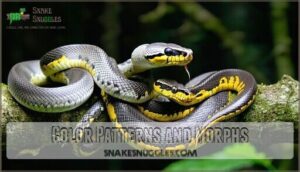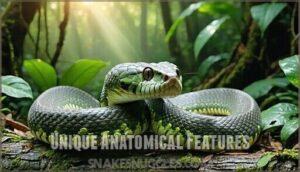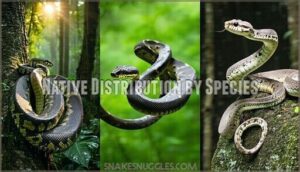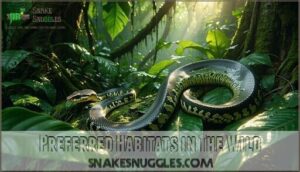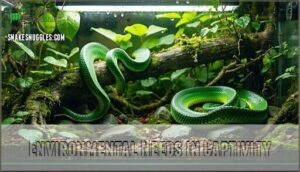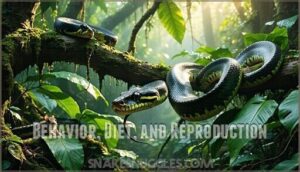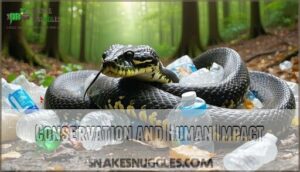This site is supported by our readers. We may earn a commission, at no cost to you, if you purchase through links.
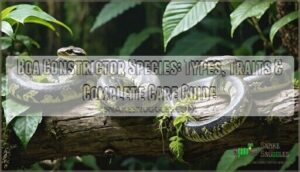 You’ll encounter three distinct boa constrictor species in the wild: Boa constrictor, Boa imperator, and Boa sigma. These aren’t just different names for the same snake—each species has evolved unique characteristics over millions of years. Boa constrictor includes eight official subspecies with distinct genetic markers, while Boa imperator and Boa sigma occupy their own territories across Central and South America.
You’ll encounter three distinct boa constrictor species in the wild: Boa constrictor, Boa imperator, and Boa sigma. These aren’t just different names for the same snake—each species has evolved unique characteristics over millions of years. Boa constrictor includes eight official subspecies with distinct genetic markers, while Boa imperator and Boa sigma occupy their own territories across Central and South America.
You can identify them by their size variations (some exceeding 10 feet), distinctive color patterns, and anatomical features like vertical pupils and heat pits. Understanding these differences matters whether you’re studying their ecology or considering captive care, since each species brings specific environmental needs and behavioral traits that reflect their evolutionary journey through diverse American landscapes.
Table Of Contents
- Key Takeaways
- Boa Constrictor Species and Classification
- Physical Traits of Boa Constrictors
- Habitat, Range, and Environmental Needs
- Behavior, Diet, and Reproduction
- Conservation and Human Impact
- Frequently Asked Questions (FAQs)
- How many Boa constrictor species are there?
- What is the friendliest species of boa?
- What is the largest type of boa?
- What is the smallest species of Boa constrictor?
- What is the average size of a boa constrictor?
- How dangerous are boa constrictor bites to humans?
- What permits are needed for boa ownership?
- How much does feeding a boa cost annually?
- Can boas escape from standard enclosures easily?
- Do boas carry diseases transmissible to humans?
- Conclusion
Key Takeaways
- You’re dealing with three distinct species, not just one snake – Boa constrictor (the largest), Boa imperator (Central American), and Boa sigma (Mexican), each with unique size, coloration, and habitat requirements
- Size matters for identification – True boa constrictors can exceed 10 feet and 40+ pounds, while boa imperators stay smaller at 6-8 feet, and some subspecies like Caulker Cay boas remain dwarf-sized at only 4-5 feet
- You’ll recognize them by their distinctive patterns – Boa constrictors have bright red tail blotches and bat-shaped saddles, while boa imperators display dark brown tails with circular saddle patterns
- Their conservation needs vary dramatically – While most species are stable, some subspecies like B. c. occidentalis require CITES Appendix I protection, and habitat loss plus the pet trade create invasive populations in places like Florida
Boa Constrictor Species and Classification
When you’re exploring boa constrictors, you’ll discover they’re not just one species but an entire genus with distinct varieties that scientists have carefully classified over decades of research.
The Boa genus contains three recognized species—Boa constrictor, Boa imperator, and Boa sigma—each with unique characteristics that help you identify which type you’re encountering.
Overview of The Boa Genus
Within the vast Boidae Family, the Boa genus stands as a cornerstone of serpent diversity. You’re looking at three distinct species that showcase millions of years of Boa Evolution. This Boa Taxonomy reveals fascinating Species Identification challenges:
- Boa constrictor – The true red-tailed giant
- Boa imperator – The Central American powerhouse
- Boa sigma – The mysterious lesser-known species
- Eight official Boa subspecies under constrictor alone
- Countless genetic localities creating identification puzzles
Understanding Genus Diversity helps you navigate Boa species classification with confidence, as each lineage carries unique traits shaped by geographic isolation and environmental pressures across the Americas. These snakes are also found as invasive species in Florida.
Distinguishing Boa Constrictor, Boa Imperator, and Boa Sigma
You’ll identify these three species through key morphological differences and genetic distinctions. Boa constrictor reaches the largest size with bright red tail blotches and bat-shaped saddle patterns. Boa imperator stays smaller with dark brown tails and circular saddles. Boa sigma, found only in western Mexico, requires genetic analysis for definitive identification due to habitat overlap with related species.
These snakes are non-native in Florida, with established breeding populations primarily in Miami-Dade County.
Official Subspecies and Localities
You can identify Boa constrictors through eight official subspecies and numerous localities that show distinct genetic markers. Each subspecies has unique traits that help with subspecies identification, though locality genetics often create confusion in morph variations.
Here are the recognized subspecies:
- B. c. constrictor – Amazon basin populations with classic red-tailed patterns
- B. c. occidentalis – Argentine boas reaching 10+ feet with high contrast markings
- B. c. longicauda – Tumbes locality from Peru, rarely exceeding 6 feet
- B. c. ortonii – Northwestern Peru mountain populations with unique coloration
- B. c. sabogae – Pearl Islands dwarf locality showing insular adaptations
Conservation status varies dramatically between subspecies. B. c. occidentalis holds CITES Appendix I protection due to habitat threats, while island populations face extinction risks. They’re known to thrive across Central and South America. Understanding these distinctions prevents hybridization risks in captive breeding programs and aids targeted conservation efforts for vulnerable localities.
Physical Traits of Boa Constrictors
You’ll recognize boa constrictors by their impressive size and distinctive patterns that make each individual unique.
These powerful snakes display notable physical variations across different subspecies and localities, from their muscular build to their striking coloration.
Size and Weight Variations
Your boa constrictor’s size depends on which subspecies you’re keeping and their genetic background. Boa imperator usually reaches 6-8 feet, while true boa constrictor can hit 10+ feet. Subspecies weights vary dramatically – some localities stay compact at 15-20 pounds, others bulk up to 40+ pounds.
Captive growth often exceeds wild maximums due to consistent feeding. Growth factors include genetics, diet, and temperature regulation. Captive boas often experience increased weight gain compared to their wild counterparts.
Color Patterns and Morphs
Natural genetics create stunning diversity in boa constrictors through pattern genetics and regional differences. Wild-type specimens display tan-to-gray backgrounds with dark saddle markings, while selective breeding produces over 100 morph variations, including Albino, Snow, and Motley types.
Color mutations range from hypomelanistic pastels to anerythristic grays. Argentine Boa and Boa Imperator localities show distinct traits, with RedTail Boa subspecies exhibiting vivid copper hues that distinguish them from standard boa constrictors.
Unique Anatomical Features
Beyond their impressive size, you’ll notice several distinctive anatomical features that set boa constrictors apart from other snakes. These adaptations help them thrive as ambush predators.
- Pelvic spurs – Small vestigial limbs near the tail base, remnants from their evolutionary past
- Vertical pupils – Elliptical eye shape perfect for their nocturnal hunting lifestyle
- Heat pits – Specialized sensors along their lips that detect warm-blooded prey
- Muscular build – Powerful body construction enabling their signature constricting ability
Sexual Dimorphism
When comparing males and females, you’ll notice striking Breeding Differences in boa constrictor species. Female Size usually dominates, with females growing 20-30% larger than males across most Boa Subspecies. Male Markings often appear more vibrant, while Growth Rates favor females reaching maturity later but achieving greater length.
These Dimorphism Causes stem from reproductive strategies, where larger females produce more offspring, defining key Boa Constrictor Characteristics for successful Boa Subspecies Identification.
Habitat, Range, and Environmental Needs
You’ll find these extraordinary snakes across diverse regions, with boa constrictors thriving in South American rainforests while boa imperators prefer Central American and Mexican territories.
Understanding their natural habitat requirements becomes essential when you’re considering proper captive care or simply appreciating how habitat loss threatens their survival.
Native Distribution by Species
Each boa species claims its own territory across the Americas, with distinct Distribution Factors shaping their ranges. South American Boa constrictor dominates from Colombia to northern Argentina, while Central American Boa imperator rules from Mexico through Panama. Mexican Boa sigma stays put along Pacific coasts.
- Boa Constrictor Range spans the widest territory, covering most of South America east of the Andes
- Boa Imperator Habitat extends through Central America’s rainier regions and northwestern South America
- Boa Sigma Location remains restricted to western Mexico’s drier Pacific coastal zones
Preferred Habitats in The Wild
Across diverse rainforest ecosystems and terrestrial biomes, you’ll find boa constrictors mastering their arboreal niches in subtropical climates. These adaptable reptiles thrive in dense vegetation, utilizing natural shelters like hollow logs and rock crevices.
Snake habitats vary from Brazilian rainforests to Peruvian cloud forests, where boa constrictor habitat requirements include consistent humidity and temperature regulation essential for reptile ecology success.
Environmental Needs in Captivity
You’ll need a proper Enclosure Size for your boa constrictor—minimum 6x2x2 feet for adults. Maintain a Temperature Gradient from 78-88°F with basking spots reaching 90°F. Keep Humidity Levels between 50-60%. Choose an appropriate Substrate Choice like cypress mulch or paper towels.
Lighting Needs include day/night cycles with UVB optional. Consider appropriate habitat products to guarantee ideal living conditions.
These Reptile Enclosure Requirements promote healthy Snake Care for your Exotic Pets through proper Reptile Pet Care.
Impact of Habitat Loss
Habitat loss devastates boa constrictor populations worldwide. Deforestation Effects and Snake Habitat Destruction force these snakes into smaller territories, creating deadly challenges:
- Prey Scarcity from ecosystem disruption limits food sources
- Fragmentation Impact isolates populations, reducing genetic diversity
- Climate Change and Environmental Damage alter temperature patterns vital for survival
Invasive Species compound these problems, while effective Conservation Strategies require immediate Snake Conservation action to protect remaining habitats.
Behavior, Diet, and Reproduction
You’ll find boa constrictors are surprisingly calm and predictable once you understand their natural behaviors and needs. These powerful snakes follow clear patterns in feeding, breeding, and daily activities that make them manageable pets when properly cared for.
Behavioral Patterns and Temperament
Boa constrictors showcase notable behavioral adaptability, shifting from aggressive wild temperament to surprisingly docile captive behavior. These serpentine masters employ stealth-based hunting strategies, relying on ambush tactics rather than active pursuit.
Masters of adaptation, boa constrictors transform from wild predators to surprisingly gentle captives through patient handling
| Behavior | Wild | Captive |
|---|---|---|
| Hunting Strategies | Ambush predation, nocturnal activity | Feeding response to movement |
| Social Interactions | Solitary except during mating | Tolerates regular handling |
| Docility Levels | Defensive, may strike when threatened | Generally calm with proper care |
| Temperament | Wary, stress-sensitive | Adapts well to routine |
| Activity Patterns | Peak activity at dusk/dawn | Adjusts to keeper’s schedule |
Red-tailed boa specimens demonstrate individual personality variations, with some remaining more defensive while others become remarkably trusting. Boa snake characteristics include territorial behavior in wild settings, contrasting sharply with their adaptability to human interaction in captivity.
Feeding Habits and Diet Requirements
Wild prey determines a boa constrictor’s nutritional needs. You’ll feed captive boa constrictors appropriately sized rodents every 1-2 weeks, matching prey size to your snake’s girth. Adult boas consume rabbits or large rats, while juveniles need smaller mice.
Proper feeding frequency prevents obesity in captivity, unlike their opportunistic wild diet. Boa breeding programs emphasize consistent nutritional protocols for ideal health outcomes. Many owners purchase frozen rodents in bulk for convenience.
Reproduction and Lifespan
Understanding your boa’s reproductive cycle helps you provide better care throughout their lives. Female boa constrictors reach sexual maturity around 2-4 years, with males maturing slightly earlier. The gestation period lasts 100-125 days, producing 10-64 live young who achieve newborn independence immediately after birth.
In captivity, boa constrictors enjoy a captive lifespan of 20-30 years, substantially longer than their wild longevity of 7-12 years due to predation and environmental challenges.
Handling and Socialization
Professional snake-handling requires patience and consistency. Regular, gentle interaction helps boa constrictors develop trust through temperament training, reducing stress responses over time. Safe handling techniques and recognizing stress signals are essential for pet snake ownership success.
Understanding reptile behavior understanding is vital for preventing defensive actions. Proper socialization benefits both handler and snake, making boa snakes more manageable in the expanding snake pet trade market.
Conservation and Human Impact
While you might think boa constrictors are thriving everywhere, many subspecies face serious conservation challenges from habitat destruction and the illegal pet trade. Understanding these threats is essential for protecting these impressive serpents for future generations.
Conservation Status of Boa Species
Most boa species enjoy relatively secure conservation status, with boa constrictor listed as "Least Concern" on the IUCN Red List. However, you’ll find some subspecies facing greater challenges. Boa constrictor occidentalis receives CITES Appendix I protection due to population fragmentation in Argentina. Trade monitoring through CITES Appendix II regulates most other boa species.
Legal protections vary by region, with some island populations like Puerto Rico’s recovering through targeted wildlife conservation efforts and habitat restoration programs. These snakes are adaptable, thriving in tropical rainforests and savannas.
Threats From Habitat Destruction and Poaching
Human pressure threatens boa populations through habitat fragmentation and illegal wildlife trade. Deforestation destroys critical ecosystems while poachers target boas for their valuable skins. These combined threats push several subspecies toward vulnerable status, requiring immediate conservation strategies.
Major threats include:
- Habitat Fragmentation – Agricultural expansion fragments rainforest homes
- Illegal Wildlife Trade – Skin harvesting for luxury goods markets
- Deforestation – Logging operations destroy nesting and hunting grounds
- Urban Development – Cities expand into natural boa territories
- Climate Change – Alters temperature and humidity requirements
Pet Trade and Invasive Risks
The global pet trade moves thousands of boa constrictors annually, creating serious problems when exotic pet releases occur. These escaped boa snakes establish invasive species populations in places like Florida, where they’ve reduced native wildlife by 40%. Disease transmission risks from pet trade boas include Salmonella and parasites affecting humans and wildlife. Captive boa products are often needed for their care.
Trade regulation enforcement remains inconsistent globally, while responsible pet ownership education has reduced releases by 20% in high-risk areas.
Conservation Efforts and Legal Protections
Since CITES regulates international Boa constrictor trade, you’ll find these snakes protected through habitat preservation programs and population monitoring efforts. Captive breeding reduces wild collection pressure while trade regulations prevent invasive species establishment.
Snake conservation status varies by subspecies, with some receiving stronger legal protections. Conservation groups focus on maintaining genetic diversity through responsible breeding programs.
Frequently Asked Questions (FAQs)
How many Boa constrictor species are there?
You’ll find three recognized species within the Boa genus: Boa constrictor, Boa imperator, and Boa sigma. Previously, scientists classified Boa imperator as a subspecies, but research established it as distinct.
What is the friendliest species of boa?
You’ll find Boa imperator, often called the Central American boa, usually proves to be the most gentle giant among boa species.
These docile serpents generally display calmer temperaments and adapt well to handling, making them popular choices for experienced reptile enthusiasts.
What is the largest type of boa?
The Boa constrictor species reaches the largest size among true boas, with adults averaging 6-10 feet but rare specimens exceeding 13 feet and weighing over 100 pounds.
What is the smallest species of Boa constrictor?
Among recognized boa constrictor subspecies, Caulker Cay boas are possibly the smallest race of common boa, reaching only about 4-5 feet in length when fully grown. **You’ll find these dwarf boas uniquely adapted to island life.
What is the average size of a boa constrictor?
You’re looking at a snake that usually measures between 6 and 10 feet, with some individuals stretching even longer.
Most adults weigh 15 to 40 pounds, showing off a muscular frame and striking, saddle-shaped patterns.
How dangerous are boa constrictor bites to humans?
You’ll experience non-venomous but painful puncture wounds if bitten, as their backward-curved teeth create deep lacerations that bleed substantially and risk bacterial infection requiring proper wound care.
What permits are needed for boa ownership?
Permit requirements vary by location. These permits often involve background checks, proof of secure enclosures, and adherence to certain guidelines for the snake’s care.
Check with your local wildlife department for specific regulations.
How much does feeding a boa cost annually?
You’ll spend roughly $200-400 annually feeding your boa, depending on its size and prey costs. Adult boas usually eat one appropriately-sized rodent every 2-3 weeks, making feeding expenses quite manageable.
Can boas escape from standard enclosures easily?
Boas can escape standard enclosures if you don’t secure them properly. They’re powerful, persistent climbers who’ll exploit loose lids, gaps, or weak latches.
Quality locks and tight-fitting tops prevent most escapes.
Do boas carry diseases transmissible to humans?
Thinking you’re immune to serpent-induced sickness? You’re not invincible — snakes carry Salmonella bacteria that’ll give you diarrhea, fever, and cramps if you don’t wash your hands after handling.
Most snake diseases don’t jump to humans though.
Conclusion
Understanding boa constrictor species transforms you from a casual observer into an informed enthusiast who can appreciate these extraordinary serpents like Victorian naturalists with their pocket magnifying glasses. Whether you’re researching the eight subspecies of Boa constrictor, distinguishing between Boa imperator and Boa sigma, or planning proper captive care, this knowledge guides responsible interaction with these impressive predators.
Each boa constrictor species represents millions of years of evolution, deserving our respect and protection.


